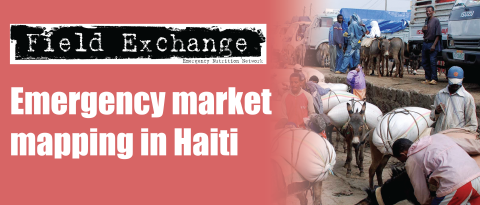Micro-credit in refugee situations
Summary of published research1
Micro-credit and other types of loan programmes have not been widely attempted within refugee and internally displaced population (IDP) contexts largely due to the fact that repatriation, resettlement or further displacement may prevent repayment of loans. However, an increasing number of refugees and IDPs remain 'stuck' in protracted situations, creating potential for using credit-based interventions to support their livelihoods. A recent paper based on a compilation of best practices and lessons learned from the 'Alchemy Project'2 has been made available by the Feinstein International Centre.
The paper identifies the main problems affecting loan programmes in refugee situations as:
- The difficulties around repatriation, resettlement and onward migrations, which creates instability and problems with repayment.
- Isolated camps and restrictions on movement that create market access problems and transportation constraints.
The main lessons are:
- Micro-credit is not for everyone.
- There is a need to make loan size and type appropriate for clients, markets and community.
- Do not accept low repayment rates.
- Include training, monitoring and evaluation in programme design.
Micro-credit is not for everyone
So called 'vulnerables' are seldom the most appropriate candidates for micro-credit and their presence in a programme can both undermine the programme and increase the client's vulnerability by exposing them to debt. Microcredit should be provided only to stable, economically active refugees who have demonstrated their own initiative in starting a business. Good candidates might also be refugees with prior micro-credit experience or experience with formal credit institutions like banks.
Bad practices by unqualified agencies trying to do micro-credit include:
- accepting poor repayment rates
- doing nothing about absconders or defaulters
- charging inappropriate or unsustainable interest rates
- calling a 'grant' a 'loan'
- allowing loans to be used for consumption purposes
- targeting micro-credit at vulnerable populations.
There are often contradictions between the target group that a non-governmental organisation (NGO) is mandated to support in a refugee camp context, and whether that group can be supported with credit. Donors and UNHCR often require that assistance programmes are targeted at the most vulnerable in the refugee population.
The authors argue that livestock and in-kind loans should be used to support those not ready for micro-credit. Refugees who are not appropriate candidates can best be helped with traditional relief, or less onerous in-kind loans or small livestock programmes. In-kind loan programmes have less demanding repayment requirements, and can be more easily managed by a relief agency. Livestock and in-kind loans can support a variety of people, including new arrivals or so-called 'vulnerables' such as childheaded households and the disabled.
The provision of small stocks (goats, sheep, chickens, ducks, etc) either for breeding or trading purposes can help launch livelihoods and are good starter programmes. Successful completion of an in-kind loan programme can prepare the client for participation in a microcredit programme.
In refugee settings it is best to be conservative about using micro-credit and to wait until the agency is familiar with the displaced community, and is working productively with relief organisations, groups and leaders.
Good programme design
Before designing and implementing a credit programme, NGOs should conduct a market study, identifying market constraints and possibilities for clients as well as risk. Good loan appraisal or well designed group loan methodology will prevent problems arising from repossession, and is a first step in identifying clients who might eventually be unable to make repayments. In refugee situations, various loan conditions, including legal documentation and collateral are missing or compromised. But this need not necessarily prevent the loan, if appropriate alternatives can be identified. It might be possible to waive documentation requirements once the implementing agency is familiar with the community and has the cooperation of key members and leaders who can help detect loan risks. Alternative forms of collateral can be identified. For example, where refugees have access to farmland, collateral can take the form of vegetables produced by the refugees that are assessed for their market value.
In certain situations, refugees may lack any form of collateral and other ways to ensure repayment, such as group pressure, are absent. Under these circumstances, some agencies have provided micro-credit using controversial repayment strategies. These include working with the government so that refugees who did not repay their loans were not permitted to renew their documents.
Given the existence of a grant mentality amongst many refugee populations, it is best not to associate micro-credit programmes with UNHCR or relief organisations that have traditionally handed out grants. Furthermore, micro-credit programmes should never be attempted by untrained relief agencies. The skills and mindset needed to manage and administer micro-credit programmes are rarely found in traditional relief programmes.
Loan size, interest rates and repayment frequency
Loan size should be appropriate for the client's enterprise. For refugees it is important that loan amounts are appropriately sized to meet the special marketing needs of refugees which may include transport and marketing costs. These should be based on institutional cost assessment, inflation, market rates, risk and client capacity. Interest is the way in which a programme is made sustainable by creating additional income beyond repayments that cover administrative costs. In Islamic areas, where interest cannot be charged, service charges on the loan can be imposed instead. Interest rates can be problematic amongst poor refugees. Some experts have suggested that since refugee programmes are not meant to be sustainable, charging nominal interest can be a way to create a good credit culture.
Provision of a mix of services
For refugees with no in-country business experience, marketing assistance can help businesses. Refugees often cannot access markets and cash economies either because they live in isolated and remote border areas, or because the government's policy requires refugees to stay in camps or restricts freedom of movement.
Training of individuals, loan groups and loan committees before loan disbursement is highly valued by group members, and increases the success of programmes. The existence of organised groups in the community is an asset in loan programmes, as these create strong pressures to repay, groups can combine funds to finance larger businesses and groups are self-monitoring. Group loan schemes only work in environments of trust. Group lending is inappropriate if clients are unwilling or unable to take responsibility for each other's debts. In many refugee and urban contexts, there is a lack of trust and it may be preferable to work with individuals, and put in place other safeguards to reduce the risk of absconding and non-payment. In some camps, traditional rotating credit schemes familiar from the home country are re-started by the refugees themselves. It is best to work with existing groups.
Resettlement and repatriation
All parties involved with the refugees, including the host government, refugee leaders, resettlement organisations and UNHCR, must build an understanding about how repatriation or resettlement will be managed in the loan programme. When UNHCR initiates voluntary repatriation or resettlement, agencies can plan repayment schedules accordingly. It might be necessary to make loan periods shorter to reduce repatriation risk in general. Loan cycles should be shorter than in non-refugee situations.
Credit programmes and refugee livelihoods are supported when governments allow refugees to work outside of camps, and disabled when there are government restrictions on refugee movement. In some cases, governments impose different requirements and restrictions on different refugee nationalities. The biggest challenge remains for NGOs and UNHCR to advocate on behalf of economic freedom for refugees and the protection of their rights to pursue a livelihood as set out in the 1951 Refugee Convention.
The economic contribution of refugee entrepreneurs can be a potential win-win situation for both host countries and refugee communities. Their economic contribution can be maximised by agencies advocating for their rights to work and freedom of movement.
1Jacobsen. K (2004). Micro-credit and other loan programmes in protracted refugee situations: Lessons from the Alchemy Project. Feinstein International Centre. http://nutrition.tufts.edu/
2The Alchemy Project is an experimental project aimed at supporting displaced people's livelihoods by providing access to a variety of forms of credit.
Imported from FEX website


